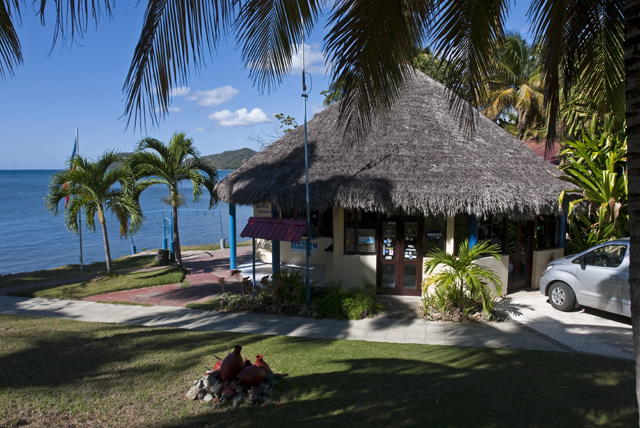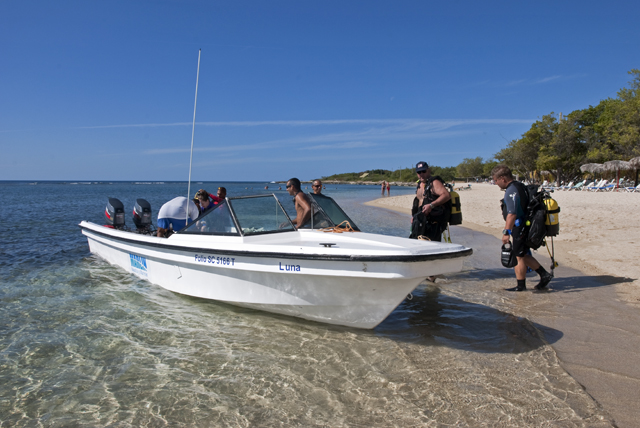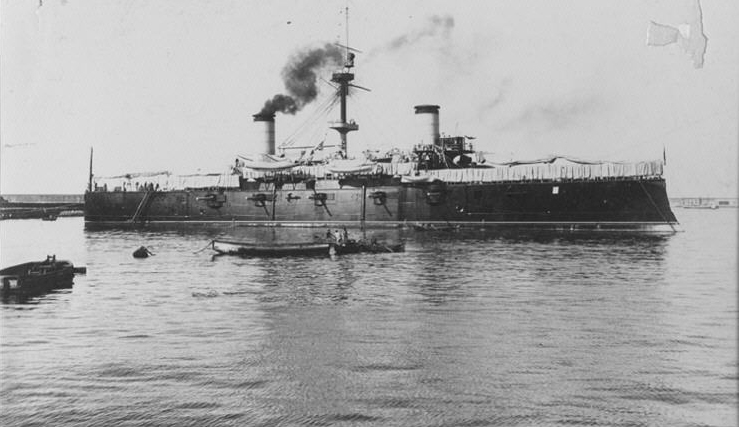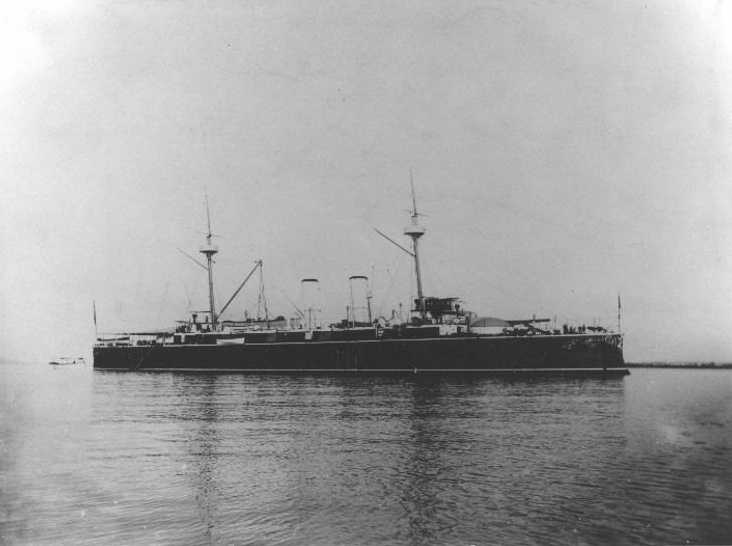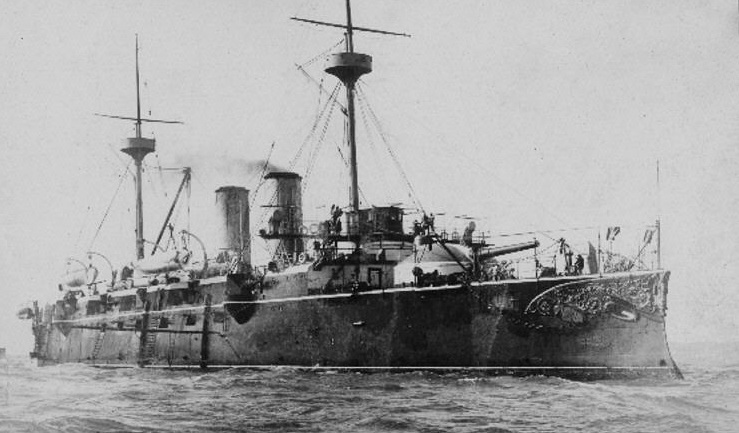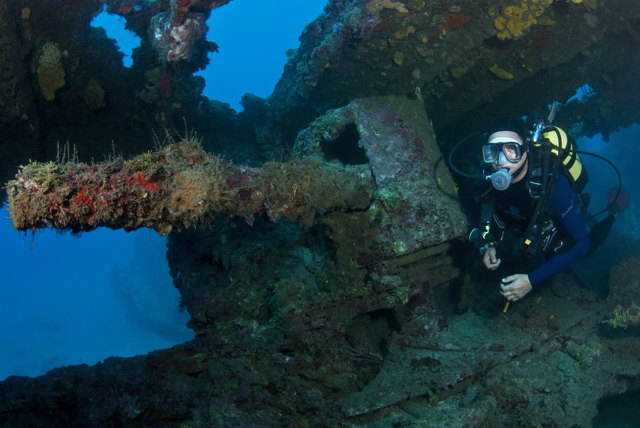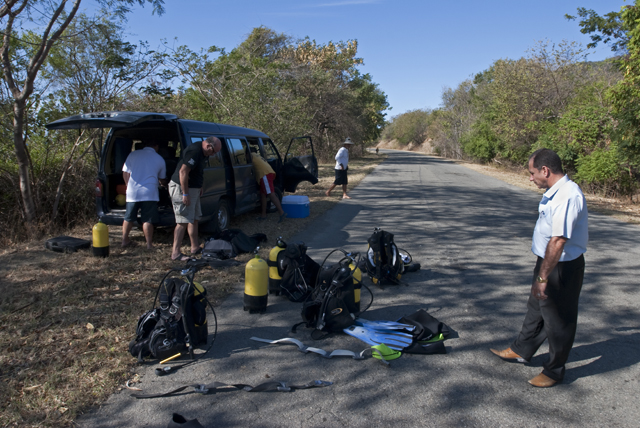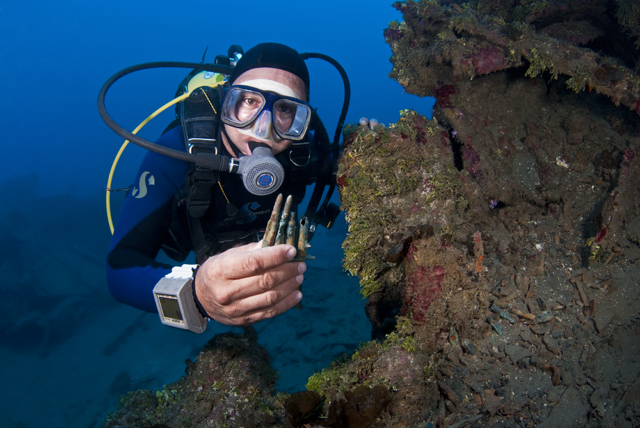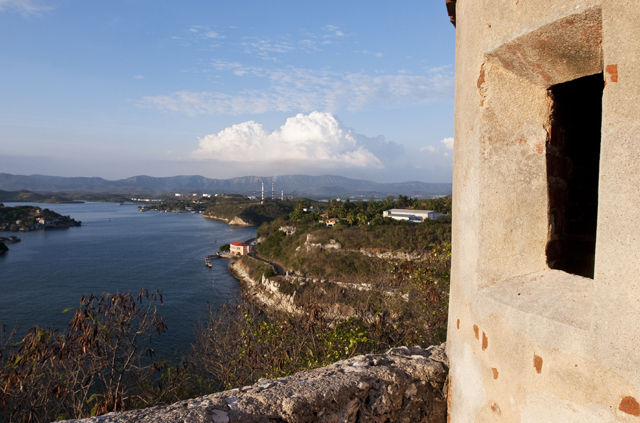News
The wrecks of the Battle of Santiago
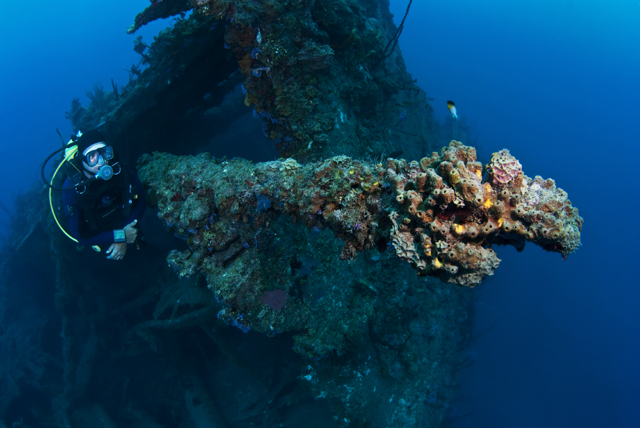
I’m always on the lookout for exciting new wreck dives, but I didn’t expect to find 4 historical warships all sunk in the same sea battle! I had spotted a poster promoting the American-Spanish civil war wrecks on the Cuba Tourism stand at the dive show, but when I investigated further no one seemed to offer any dedicated diving trips and I couldn’t find much information on the internet.
By Cuban standards the great sea battle at Santiago de Cuba was their equivalent to Scapa Flow or Truk Lagoon, so what was the problem? After spending more than a century underwater maybe there just wasn’t anything left to see? I spoke with John Spencer-Ades, the owner of The Scuba Place, and firmed up plans for a full on exploratory expedition just to find out what was actually lying on the seabed.
John contacted Marlin dive centres and they recommended that I stay at Santiago for the first leg of my trip and then transfer up the coast to Guama for the final stages. Unfortunately the whole week turned out to be a fruitless exercise. Most of the wrecks are located near river mouths so the heavy summer rainfall obliterates the sites with murky water. When I spoke to the dive centre manager, Julian Bosch, he recommended a visit during the drier winter months and said he could normally guarantee crystal clear conditions. It was really frustrating to see the huge 11 inch (280mm) guns towering above the waterline and not be able to get any decent underwater pictures. I spent the rest of my time diving on a number of modern day freighters and passenger ferries located to the east of Santiago Bay, but that’s another story.
A few months later I returned with John and his friend Bruce Milani. As before, I based myself at the 5-star Melia Hotel. This was approx 20 minutes drive from the dive centre at Santiago Harbour. I stuck with my original plan to re-trace the entire sea battle starting with the wreck of the Collier Merrimac, located in the middle of Santiago bay.
Admiral Pascual Cervera Y Topete had set sail for the Caribbean with 6 Spanish warships.
Upon hearing this grave news, America mobilised the entire fleet. The North Atlantic Squadron commanded by Rear Admiral William T Sampson and the Flying Squadron commanded by Commodore Winfield Scott Sibley was ordered to hunt down and sink the Spanish warships. Several tense weeks passed by without a single sighting, and then they were spotted lying at anchor in Santiago Bay. Rear Admiral Sampson ordered an immediate blockade of the harbour entrance. Julian said the Americans attempted to stop Cervera’s Squadron from leaving the harbour by blocking the exit. The 98m long US Collier Merrimac was scuttled in the main channel but unfortunately the steering gear was damaged by gunfire and the ship drifted out of position before it sank.
The Merrimac is located just 5 minutes speed boat ride from the dive centre at a maximum depth of 20 metres. It’s only possible to dive the wreck on an incoming tide due to the amount of sediment that comes out of the harbour. The first few metres of the descent are virtually ‘pea soup’ with zero visibility. Due to the wrecks position smack bang in the middle of the harbour entrance there’s also the possibility of overhead boat traffic. Once I got through the ‘fog’ layer visibility increased to around 10-15 metres but the water had a strange fluorescent green tinge and it was still quite dark owing to the overhead silt layer. A torch is essential and some careful finning required owing to the fact that the bottom composition is made up of fine sediment. There also seemed to be a growing population of Lionfish on the wreck.
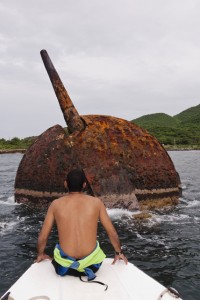
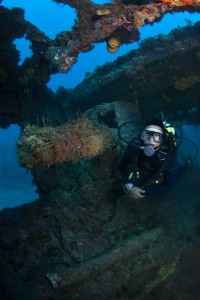 Although most of the topside structure has collapsed there is still plenty to explore. The stern area seems to be more intact with the massive propeller being the main feature. Julian showed me the huge anchor lying half buried in the sand around 10 metres off the starboard side stern. The cargo holds are still full of coal and there are portholes, anchor chains, bollards and winches to look at. I found plenty of small shoals of fish swimming about, and jellyfish are quite common.
Although most of the topside structure has collapsed there is still plenty to explore. The stern area seems to be more intact with the massive propeller being the main feature. Julian showed me the huge anchor lying half buried in the sand around 10 metres off the starboard side stern. The cargo holds are still full of coal and there are portholes, anchor chains, bollards and winches to look at. I found plenty of small shoals of fish swimming about, and jellyfish are quite common.
Although Cervera felt relatively safe holed up inside the harbour the Cuban Government wouldn’t assist with any repair work to his ships. After a 37 day stale-mate Cervera received news that US land forces were rapidly advancing on his position. This left the veteran Admiral only 2 options; either surrender or make a break for it. At 9-00am on Sunday 3rd July 1898, when the Americans were busy with religious services, he gave orders to up anchor and leave the bay.
The ships came out in single file on a westerly heading. Cervera’s flagship, Infanta Maria Teresa was in the lead followed by armed cruisers Cristobal Colon, Almirante Oquendo and Vizcaya. The general idea was to hug the coastline until they got past the American warships and then make a dash for the open sea. Earlier that morning some of the American ships including the flagship USS New York had left position to rendezvous with US land forces. This had left a gap in the blockade line.
Lookouts spotted the Spanish ships and sounded battle stations. Armed Cruiser USS Brooklyn engaged the lead ship Infanta Maria Teresa. Cervera’s brave plan was to draw fire so that the rest of his squadron could escape. The 111m long (7,000 ton) flagship, bombarded by shells, eventually caught fire and ran aground. Most of the crew escaped and swam safely ashore including the Admiral. I’m not quite sure what happened to the wreck of the infant Maria Teresa. Julian said he had found some wreckage close to shore but nothing really substantial. I did find some reference to a salvage operation, so maybe that was the ship’s fate?
Armed Cruiser Almirante Oquendo managed to get slightly further along the coast before receiving a barrage of direct hits from USS Iowa. The stricken ship changed course and was scuttled in the shallows. The wreck is approximately 1 hour speed boat ride from the dive centre. I could see the huge deck guns pointing skywards way before we reached the site. The circular bow turret is almost completely out of the water. The stern turret is submerged and only the barrel breaks the surface. Julian had already warned me that the prevailing cold front would make surface conditions quite choppy but I wasn’t prepared for the same murky conditions underwater, in fact it was slightly worse than the summer time. I finned along the entire length of the hull to the deepest point at about 10 metres but conditions didn’t get any better. Most of the super structure is a mass of twisted metal but I could still identify the massive boilers, a row of port holes and the main mast. I also found plenty of reef fish, morays and lobsters milling about.
Vizcaya had an hour long battle with USS Brooklyn and was reported to have been hit around 200 times. A huge explosion forced the ship inshore where she eventually ran aground. This site is approximately 2.5 hours by speedboat from the dive centre. The bow turret also breaks the surface but this time the aft gun and turret lie upside down on the seabed. Unfortunately the underwater conditions were just as disappointing as the Oquendo. Most of the structure is covered in soft corals making it very difficult to differentiate wreck from reef. I managed to wriggle inside the upturned turret and take a look at the guns firing mechanism but there wasn’t much else to penetrate. For me the best ‘lost’ picture opportunity was the giant turret mounting wheel, which standing vertically, reminded me of a ‘Stargate’. I could picture a diver swimming through the metal ring, torch in hand, but alas it wasn’t to be on this trip.
The 2 Destroyers Pluton and Furer tried to escape by turning east. But they were shelled by USS Iowa, USS Indiana and eventually by USS New York. On receiving news of the battle, Flagship USS New York had turned around and come back. Furor was sunk and Pluton ran aground and blew up. Julian said there was nothing of any significance left to see.
The Cristobal Colon managed to break away from the pursuing American warships. The 112m long (8000 ton) Italian built ship was a new second generation cruiser. With a top speed of 20 knots she was easily the fastest ship in the Spanish squadron. But Captain Emilio Diaz Moreu had a number of concerns. Firstly the ship had been dispatched to Cuba without her full armament. The main 10 inch gun was missing. For show a dummy wooden gun had been fitted to the mounting. Secondly the supply of high grade British coal, fuelling the furnaces, was about to run out. The low quality coal remaining would not allow them to maintain their current speed. This meant that the US ships would eventually catch them up. USS Oregon managed to fire 2 shots across Colon’s stern. In Captain Moreu’s mind this was far too close for comfort. He gave the order to open the stop cocks and scuttle the ship.
The wreck of the Colon was way beyond the range of Julian’s speedboat. John made arrangements for us to stay at the 3.5-Star Brisas Sierra Mar Hotel located approximately 2 hours (60km’s) taxi-drive from Santiago at a place called Guama. We spent a night at the Hotel and then in the morning travelled another 2 hours by minivan to the shore diving site. I spoke to Edgar, the Hotel’s dive centre manager, before we left and he said ‘there’s a cold front coming’. From past experiences I already knew that this meant another bout of strong winds and unsettled seas. Not ideal conditions for photography or for that matter a shore dive. As we drove along the coast road I could see a coffee coloured ‘dirty water’ slick oozing from the shallows blending with clearer blue water about 200 – 300 metres out to sea. Edgar said not to worry all would be okay but my scepticism was rising fast.
Edgar said that the wreck used to be a popular dive site up until Hurricane Ike struck in September 2008. We edged our way over a concrete bridge that had been decimated by the full force of the storm. It looked more like a scene from an earthquake disaster movie. Edgar said that the long journey had discouraged a lot of divers.
We kitted up by the roadside shaded from the sun by overhanging trees. Edgar disappeared down a steep sided embankment carrying his full diving kit so we all followed suit. I slipped on the muddy slope and ended up going down on my rear end. We broke through the tree line onto a rock and pebble beach. To be honest conditions on the day were marginal at best (2m high waves) but this was the only opportunity I was going to get. We had been bumping and bashing our way over some seriously large potholes for the past 2 hours and I didn’t want to return empty handed.
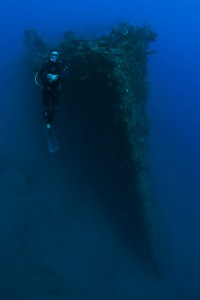
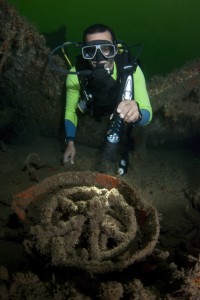 My initial head dunk underwater confirmed my concerns. I could see horizontally about 1 to 2 metres at best. But I should have put more faith in Edgar who had been diving on the wreck for more than 15 years. When we reached a depth of about 6 metres the sediment cloud dispersed leaving clear blue water. I followed Edgar over the stern and down the port side. The ship was facing directly out to sea, which seemed a strange position – I would have thought that Captain Moreu would have run aground bow first. Edgar said that the ship had probably been turned around during salvage attempts.
My initial head dunk underwater confirmed my concerns. I could see horizontally about 1 to 2 metres at best. But I should have put more faith in Edgar who had been diving on the wreck for more than 15 years. When we reached a depth of about 6 metres the sediment cloud dispersed leaving clear blue water. I followed Edgar over the stern and down the port side. The ship was facing directly out to sea, which seemed a strange position – I would have thought that Captain Moreu would have run aground bow first. Edgar said that the ship had probably been turned around during salvage attempts.
Edgar guided me to a hold full of ammunition. The bullets were held in cartridges of 5 or maybe 6. There were literally thousands of brass cases lying about. The tour continued past the funnel and on towards the bow. We stopped by one of the side-mounted 6 inch deck guns covered in coral growth. This ship must have been quite a sight during its heyday. I followed the curvature of the bow down to the seabed at 30 metres. I knelt in the sand (warily watching 3 Lionfish closing in on me) and put my camera lens on the widest possible setting for a picture.
We crossed over to the starboard side where there was a mass of mangled super structure lying on the seabed. Edgar rummaged around in the sand and pulled out a Brass Lantern still pretty much intact. This had obviously been hidden for safe keeping. I’m sure there were plenty of other artefacts waiting to be discovered inside the wreck. I circumnavigated the outside and explored most of the upper deck area. I spotted a number of entry points for some deeper penetration, but unfortunately we ran out of time.
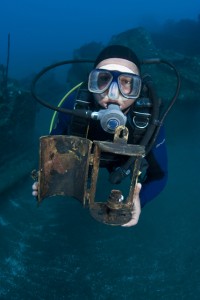
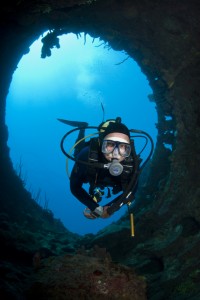 In a matter of hours the Battle of Santiago was over. The Spanish Caribbean Squadron had been completely destroyed. 6 ships had been sunk or scuttled, 474 men were either dead or injured and 1,800 men had been captured. A number of American ships had been damaged, but none were actually sunk, and only 1 US seaman was reported dead.
In a matter of hours the Battle of Santiago was over. The Spanish Caribbean Squadron had been completely destroyed. 6 ships had been sunk or scuttled, 474 men were either dead or injured and 1,800 men had been captured. A number of American ships had been damaged, but none were actually sunk, and only 1 US seaman was reported dead.
I’m not sure this trip would be suitable for die-hard wreck fanatics (although combined with the modern day shipwrecks it might work?). They are not that deep and penetration is limited. I would say it’s better suited for divers with some spirit of adventure that like historical wrecks and don’t mind travelling slightly off the beaten track. There are no other divers or dive boats operating in the area.
Before leaving Santiago de Cuba I made a visit to UNESCO site Castillo de San Pedro de la Roca, located at the entrance to Santiago Bay. Looking down from the ramparts I wondered what it must have felt like to see the whole battle raging below. I sat and watched the lowering of the flag ceremony as the sun dipped below the horizon. A Cannon fired a single salvo out to sea marking the end of another memorable day.
News
Santa Divers take the Plunge for Charity

Ho Ho Ho! Vobster Quay’s recording-breaking charity Santa diving event returns on Sunday 15th December 2024 for another round of festive fundraising frivolities. Run in aid of the Royal National Lifeboat Institution (RNLI) and Help For Heroes, this ever-popular annual fundraising event aims to raise sack-loads of cash for these two very deserving charities.
Divers of all levels are invited to grab their Santa outfits – and as much festive cheer as they can muster – and head down to Vobster Quay near Mells, Somerset for a mass sponsored Santa dive in aid of charity. In previous years, the event has attracted divers from the far corners of the UK to join in the festive merriment for a final festive dive before the Christmas and New Year break. Back in 2015, the event smashed the world record for the most Santa divers with 188 divers taking to the waters donning their festive finery – a record that remains unbeaten to this day!

Vobster Santas isn’t just about setting records – it’s also about raising some serious cash for charity. Vobster Quay encourages all divers to get into the spirit of the season to raise much-needed funds for two very deserving charities – the Royal National Lifeboat Institution (RNLI) and Help For Heroes.
Through individual sponsorship and online donations, divers can invite their friends, family and work colleagues to sponsor them to plunge into the balmy waters of Vobster Quay dressed in full festive finery. Since the very first Santa dive in 2007, the event has raised over £52,000 for charity. “It’s been over 17 years since the very first charity Santa dive took place at Vobster Quay and every year the event just keeps getting bigger and better” enthused Vobster Quay owner, Amy Stanton.
“Vobster Santas is a great way for divers to say a massive thank you to the both the RNLI and Help For Heroes – two very deserving charities close to our hearts. We’re immensely proud of all that Vobster Santas has achieved and hope that even more divers will join this year’s event on Sunday 15th December. I’m confident that we can make Vobster Santas 2024 the biggest yet!”.
Divers wishing to participate can get involved by simply registering their attendance at
www.vobster.com/event-vobstersantas.php.

Blogs
Dive into Adventure at Hideaway Beach Resort & Spa: The Ultimate Diving Destination in the Maldives

Tucked away in the remote northern Haa Alifu Atoll, Hideaway Beach Resort & Spa is a premier destination for anyone seeking an unforgettable underwater experience. With over 30 dive sites to explore, divers of all levels can witness the unique and mesmerising beauty of the underwater world. Whether you’re a seasoned diver or new to the sport, Hideaway offers an exceptional diving adventure that is not to be missed.

Explore the Beauty Beneath the Surface
Hideaway is perfectly situated near some of the most spectacular dive sites in the Maldives. The dive school and team at Hideaway offer a very personalised experience to ensure each diver gets an interactive, immersive experience.

Email: reservations@hideawaybeachmaldives.com / Call: +960 650-1515 / Website: www.hideawaybeachmaldives.com
Unique dive spots such as Theefaridhoo Thila (Heaven and Hell) as one of the 50 best dive sites in the whole of the Maldives, known for its beautiful soft coral gardens.

Email: reservations@hideawaybeachmaldives.com / Call: +960 650-1515 / Website: www.hideawaybeachmaldives.com
As the resort is located next to a channel which gives guests surprise visits from eagle rays, manta rays, guitar sharks and more.

Email: reservations@hideawaybeachmaldives.com / Call: +960 650-1515 / Website: www.hideawaybeachmaldives.com
One of the standout features of diving in the Haa Alifu Atoll is the abundance of rare and exotic marine species. The area is known for sightings of whale sharks, manta rays, turtles, and a variety of colorful reef fish. Diving at Hideaway Beach Resort & Spa offers a rare opportunity to encounter these creatures in their natural habitat, creating lifelong memories for guests.

Email: reservations@hideawaybeachmaldives.com / Call: +960 650-1515 / Website: www.hideawaybeachmaldives.com
Whether you’re exploring deep coral gardens, dramatic overhangs, or vibrant reef walls, each dive offers something new and exciting. The visibility in the Maldives is exceptional, often exceeding 30 meters, making it ideal for both underwater photography and general exploration.

Email: reservations@hideawaybeachmaldives.com / Call: +960 650-1515 / Website: www.hideawaybeachmaldives.com
Diving for All Levels
At Hideaway, we believe that everyone should have the opportunity to experience the thrill of diving. That’s why we cater to divers of all levels, from beginners to experienced professionals. Our professional dive center, led by expert instructors, offers a range of courses and guided dives. If you’re new to diving, you can start with an introductory course that will teach you the basics of scuba diving in a safe and controlled environment.

Email: reservations@hideawaybeachmaldives.com / Call: +960 650-1515 / Website: www.hideawaybeachmaldives.com
For more experienced divers, we offer advanced dive courses and guided excursions to some of the more challenging dive sites. Our instructors are knowledgeable and passionate about the local marine life, ensuring that every dive is not only safe but also informative and enjoyable.

Email: reservations@hideawaybeachmaldives.com / Call: +960 650-1515 / Website: www.hideawaybeachmaldives.com
Exclusive Diving Offer
To make your stay even more unforgettable, Hideaway is offering an exclusive diving package designed to enhance your experience both above and below the water. When you book a minimum 7-night stay, you’ll receive:
- 35% discount on room rates.
- Complimentary diving: 3 dives per person for 2 guests, allowing you to experience the beauty of the Maldives underwater world.
- Free meal plan upgrade: enjoy a complimentary upgrade from Bed & Breakfast to Half Board, or from Half Board to Full Board. Guests who prefer the White Platinum Plan (WPP) can avail it at a discounted rate.
This incredible offer provides the perfect opportunity to experience world-class diving while enjoying all the luxury and comfort that Hideaway Beach Resort & Spa is known for.

Email: reservations@hideawaybeachmaldives.com / Call: +960 650-1515 / Website: www.hideawaybeachmaldives.com
Combinable Offers for Even More Value
This diving offer can also be combined with our Anniversary and Honeymoon offers, allowing you to create the perfect celebration package. Whether you’re celebrating a milestone or simply seeking a romantic getaway, this offer ensures that you can enjoy the best of both worlds – luxurious accommodations and unforgettable diving adventures.

Email: reservations@hideawaybeachmaldives.com / Call: +960 650-1515 / Website: www.hideawaybeachmaldives.com
Terms & Conditions
- This offer is available exclusively for bookings made through the official Hideaway Beach Resort & Spa website using a specific booking code.
- The offer cannot be combined with other promotions available on the website or through other channels, nor can it be redeemed for cash.
- All dives are subject to weather conditions, ensuring the safety and enjoyment of all guests.
- Black-out dates: This offer is not available from 24th December 2024 to 9th January 2025.
To book this exquisite offer, use the Promo Code: SCUBA24FD

Email: reservations@hideawaybeachmaldives.com / Call: +960 650-1515 / Website: www.hideawaybeachmaldives.com
Hideaway is not just a resort; it’s a sanctuary for those seeking peace, adventure, and luxury. With spacious villas, private pools, and world-class dining options, the resort offers everything you need for a perfect holiday. From tennis, golf, gym, cycling to the exquisite underwater activities, unique dining options, Hideaway has something for everyone. And for diving enthusiasts, it provides an unparalleled opportunity to explore some of the most beautiful dive sites in the world.

Email: reservations@hideawaybeachmaldives.com / Call: +960 650-1515 / Website: www.hideawaybeachmaldives.com
Our dive center is fully equipped with state-of-the-art gear, ensuring that every dive is safe, comfortable, and enjoyable. Our instructors are passionate about the underwater world and are eager to share their knowledge with you, whether it’s your first dive or your 100th.

Email: reservations@hideawaybeachmaldives.com / Call: +960 650-1515 / Website: www.hideawaybeachmaldives.com
The Ultimate Dive Adventure Awaits
If you’re looking for an unforgettable diving holiday in the Maldives, look no further than Hideaway Beach Resort & Spa. With over 30 dive sites, unique marine life, and exclusive offers, we provide the ultimate underwater experience. Whether you’re celebrating a special occasion or simply seeking adventure, our diving package offers exceptional value and incredible memories.

Book now through our official website to take advantage of this exclusive offer and prepare for the dive adventure of a lifetime.
Email: reservations@hideawaybeachmaldives.com
Call: +960 650-1515
Website: www.hideawaybeachmaldives.com

-

 News1 month ago
News1 month agoIconic SS United States to become the World’s Largest Artificial Reef
-

 Blogs3 months ago
Blogs3 months agoNovoScuba’s Game-Changing Approach for Dive Store Owners: WE PAY YOU!
-

 News2 months ago
News2 months agoBook Review – 52 Assignments: Underwater Photography
-

 Gear News2 months ago
Gear News2 months agoDYNAMICNORD – New German diving brand enters the British market
-

 News2 months ago
News2 months agoExploring Cenote El Pit: A Diver’s Dream
-

 Gear News2 months ago
Gear News2 months agoTry BARE drysuits (and maybe even win one!) this Friday with Sea & Sea at North West Dive Fest
-

 News3 months ago
News3 months agoComing Soon – 52 Assignments
-

 News3 months ago
News3 months agoSave £200 per person per week at Pole Pole Lodge with Dive Worldwide


